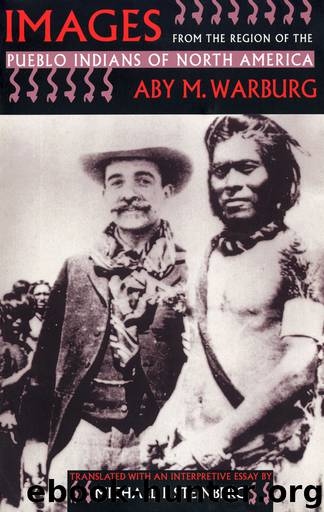IMAGES from the Region of the Pueblo Indians of North America by ABY M. WARBURG

Author:ABY M. WARBURG
Language: eng
Format: epub
Publisher: CORNELL UNIVERSITY PRESS
Published: 2016-08-01T16:00:00+00:00
Autobiographical Conundrums, Recalled in 1923
Warburg’s early biography, as reconstructed from correspondence and from the autobiographical elements of the 1923 lecture notes, points to a crucial but highly sensitive, indeed tortured formula for the late-nineteenth-century German intellectual: the conviction that Judaism is the cultural partner of paganism, not of rationality. An acceptance of this formula in Warburg’s lifelong thinking makes the “fortress rationality” position untenable. In question are both the fragmented subject and the diagnosis of Judaism in various historical manifestations—including even that of the Hamburg Jewish patriciate—as a vestige of cultural primitivism. Warburg’s desire for distance from contemporary religious practice recalls Freud’s. For Warburg as for Freud, the continuum from the primitive and the irrational to the modern and the rational was a fluid one. In the later cultural writings of Freud, the cultural potential of this fluidity grew more ominous; for Warburg it had always been a terrible threat. On the personal level, Warburg never achieved a secure distance from the same cultural demons; for Freud this was not a concern. It seems clear that, in Warburg’s mind, the lecture on the serpent dance in April 1923 was his own dance with the serpent, a coming to terms with the two dialectics that had determined, and indeed undermined, his lifelong sensibility: primitivism, or paganism, and rationality; and paganism and Judaism.
The preparatory lecture notes digress repeatedly into autobiographical issues. Such references can be corroborated by a significant body of early correspondence. Thus, in a recent article entitled “Aby Warburg in His Early Correspondence,” A. M. Meyer defined the issue: “Exactly what was the relation between Warburg’s research on paganism in the Renaissance and his mediations and fears about Judaism (and Jews) remains of course the problem.”29 Meyer draws from the young Warburg’s letters to his family to form a rich picture of the sensibilities of his personal crisis as well as of a more general crisis among the assimilated Jewry of Wilhelmine Germany. In the Warburg family, religious practice had become—certainly in Aby’s eyes—formalistic. (As Meyer points out—correcting some recent conjecture—the young Aby Warburg did not read the Talmud in his childhood home and received no religious instruction fram his father, the banker Moritz Warburg. Aby learned Hebrew from his mother.)30 It thus presented a double danger: that which was inherent, for Warburg, in ritual paganism, as well as that of increased vulnerability to anti-Semitism. Meyer has shown clearly how severe this conflict became during the years of Warburg’s intellectual formation.
In the 1923 lecture notes, Warburg recorded his earliest childhood memory as the demonic dreams he suffered while ill with typhus at age six, in 1873. The imagery of these dreams was inspired, he speculates, from the illustration in Balzac’s “Die kleinen Leiden des Ehestandes” (Petites misères de la vie conjugale), which had been read to him.31 In the notes of the same day, he also discusses the second traumatic episode of his childhood: the illness of his mother in the summer of 1875, while vacationing in the Austrian resort of Ischl.
Download
This site does not store any files on its server. We only index and link to content provided by other sites. Please contact the content providers to delete copyright contents if any and email us, we'll remove relevant links or contents immediately.
| Anthropology | Archaeology |
| Philosophy | Politics & Government |
| Social Sciences | Sociology |
| Women's Studies |
Cecilia; Or, Memoirs of an Heiress — Volume 1 by Fanny Burney(32075)
Cecilia; Or, Memoirs of an Heiress — Volume 3 by Fanny Burney(31469)
Cecilia; Or, Memoirs of an Heiress — Volume 2 by Fanny Burney(31419)
The Great Music City by Andrea Baker(30797)
We're Going to Need More Wine by Gabrielle Union(18641)
All the Missing Girls by Megan Miranda(14788)
Pimp by Iceberg Slim(13798)
Bombshells: Glamour Girls of a Lifetime by Sullivan Steve(13698)
Fifty Shades Freed by E L James(12925)
Talking to Strangers by Malcolm Gladwell(12888)
Norse Mythology by Gaiman Neil(12861)
For the Love of Europe by Rick Steves(11558)
Crazy Rich Asians by Kevin Kwan(8898)
Mindhunter: Inside the FBI's Elite Serial Crime Unit by John E. Douglas & Mark Olshaker(8721)
The Lost Art of Listening by Michael P. Nichols(7170)
Enlightenment Now: The Case for Reason, Science, Humanism, and Progress by Steven Pinker(6879)
The Four Agreements by Don Miguel Ruiz(6326)
Bad Blood by John Carreyrou(6285)
Weapons of Math Destruction by Cathy O'Neil(5846)
